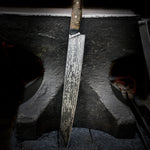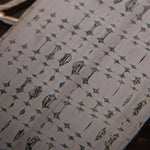Razorwire
Razorwire's distinctive pattern features a series of tightly spaced, repeating horizontal lines that alternate with small, sharp, symmetrical shapes resembling barbed wire or razor wire. The intricate and precise arrangement of these elements creates a visually striking effect, giving the billet a structured and uniform appearance with a modern, industrial edge. The fine details of the pattern demonstrate meticulous craftsmanship, making it an excellent choice for both aesthetic and functional applications.
The stainless steel version of the Razorwire pattern is created using layers of 440-C stainless razor blade steel and CPM-154 stainless steel. 440-C is known for its high hardness and excellent wear resistance, making it ideal for cutting tools and blades. CPM-154, a premium stainless steel, offers superior corrosion resistance and toughness, ensuring the billet's strength and durability while enhancing its overall performance.
The hybrid carbon steel version consists of layers of 3V carbon steel and CPM-154. 3V carbon steel is renowned for its exceptional toughness and ability to withstand heavy use without chipping, making it perfect for demanding applications. The addition of CPM-154 not only contributes to the pattern’s striking visual contrast but also improves the billet's resilience and cutting ability.
Overall, the Razorwire pattern is a stunning representation of precision and modern design, suitable for high-performance custom knives and other specialized tools. Its bold, structured look combined with the use of premium materials makes it a standout choice for those seeking both functionality and style in their Damascus steel creations.
Razorwire Pattern Damascus is known for its tight, repeating structure—symmetrical shapes that resemble barbed wire or razor edges. It delivers a sharp, industrial aesthetic with bold function.
Stainless Version: Layers of 440C and CPM-154 stainless steel. High wear resistance, toughness, and clean visual symmetry.
Carbon Hybrid: 3V carbon steel and CPM-154 combine for exceptional edge retention and striking contrast.
This pattern is ideal for tactical and performance-focused knife makers and tool builders looking for extreme precision and durability.
How to Etch Stainless & Carbon Damascus




